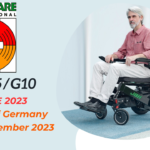A guide to an electric wheelchair How do you buy the best one
Whether you have paralysis or you’re unable to walk for long periods of time, buying an electric wheelchair requires product knowledge. In order to make the right purchase when looking to buy an electric wheelchair online, you should know about the major brands, types, and models that are available on the market. Most manufacturers do not sell power wheelchairs to consumers but rather a dealer who sells them to the end-user which is you.
If you don’t thoroughly research the product that you are going to buy, you could end having to pay restocking fees and turning your purchasing experience into a nightmare. We pride ourselves on adding as much valuable information on every product page and by having a blog, forum, and FAQ section that is constantly being updated. Learning a thing or two about the industry and product that you are going to buy is a great way to ensure your buying experience is a pleasant one so let’s get started.
What Is an Electric Wheelchair?
An electric wheelchair—also called a powered or motorized wheelchair—is a four- or six-wheel chair with a motor that runs on one or two batteries. These wheelchairs are maneuvered with a joystick and require no upper body strength. Powered wheelchair varieties range from simple, standard wheelchairs for short-term use to highly customized versions for more complex and long-term needs.
Electric wheelchairs like the ones used by Lee fall into a category called complex rehabilitation technology, or CRT. “These wheelchairs are measured and built specifically to meet each individual’s unique needs,” says Angie Kiger, a clinical strategy and educational manager at Sunrise Medical, a California-based wheelchair manufacturer. This technology includes multiple positioning options, advanced electronics and controls, adjustments for orthopedic issues and accommodations for ventilators.
What Are the Best Power Wheelchair Brands?
Pride, Golden, and Drive are the most popular manufacturers that make electric wheelchairs and they provide great products with excellent manufacturer warranties. Each manufacturer offers a service contract which is important because over time electric wheelchairs are known to need service and repair.
Pride Mobility Corp is based out of Pennsylvania with several distribution points and they have been in business for over 20 years (since 1986). Some of the most popular power wheelchairs made by Pride are the Quantum, Jazzy series, and the Go-chair. They have excellent products and they offer a very appealing warranty on all power chairs made by Pride.
Golden Technologies has based in Pennsylvania as well and has also been in since 1985. They have warehouses throughout the US and product quality products as well. They provide a 1-year in-home service contract with each sale just like Pride. Some of the popular electric wheelchairs by Golden Technologies are the Alante Sport, the Compass (and Compass HD), and the LiteRider.
Drive Mobility is based out of New York and has been around since 1984. They have excellent pricing and quality products. They are also known to provide excellent customer service and service contracts with each sale. Some of the more popular electric wheelchairs by Drive Medical are the Trident, the Cirrus Plus, and the Titan.
Key Differences Between an Electric Wheelchair and a Mobility Scooter
When people lose the ability to walk, they turn to motorized vehicles, such as a mobility scooter or a powered wheelchair. Mobility scooters are three- or four-wheel vehicles that aren’t highly customizable. Electric wheelchairs usually feature four to six wheels and can be designed to the user’s specifications. “A mobility scooter is for people who have some mobility who can transfer in and out of it,” says Lee.
Who Benefits from an Electric Wheelchair?
A powered wheelchair can be a helpful alternative or necessity for anyone unable to operate a wheelchair manually. People who cannot walk due to a permanent or progressive illness that causes disability can benefit significantly from an electric wheelchair.
Types of Electric Wheelchairs
- Standard electric wheelchairs are those that don’t fall into the travel/folding category or into the heavy-duty category but more of a mid or full-size category. These are generally a bit faster and more versatile; they aren’t really known to have extremely high weight capacities but certain models can go a long way like The P312 which is made by Merits Health that has a travel range of up to 18 miles. If you’re an average weight and size you will find that standard or full-size scooters are the most comfortable way to go.
- Travel Handicap Power Wheelchairs are much lighter than standard or heavy-duty power chairs and mostly all of them disassemble into smaller pieces making them very easy to store away and transport while traveling. They usually have a smaller body frame as well which allows them to squeeze through tight spaces such as doorways or hallways with little to no hassle. A prime example of a reliable and durable travel power chair would be the LiteRider PTC Portable by Golden Technologies. This lightweight electric travel wheelchair breaks down into 5 pieces in total weighing 116 lbs. and can easily go in the back of even the smallest of trunks. Although they do not last as long as most standard or heavy-duty power chairs electric travel chairs are the most convenient way to get around both in and outdoors.
- Folding Electric Wheelchairs are also technically considered a type of travel power chair as they are able to fold and fit into compact spaces like an airplane overhead or in the trunk of a car. Electric wheelchairs that fold are known to have a weight capacity that is lower than average typically because the framework is made with lightweight material not capable of supporting heavyweight. However, there are exceptions to that and they can be found in products like The P181 by Merits Health. Available with quite a few different seating options, this folding handicap power chair is capable of holding anywhere between 450 and 700 lbs as maximum weight capacity.
- Heavy-Duty Electric Wheelchairs are best for going outdoors and for supporting above average-sized riders. There are many options to choose from that can carry anywhere from 400 to 700 lbs. in weight capacity, one example is the Jazzy 614 power wheelchair. Heavy-duty models usually have a lot more torque to add to their performance and also a longer-lasting battery life allowing all heavy-duty power wheelchairs to go quite a traveling distance. Most importantly a majority of heavy-duty power chairs come with solid or flat-free tires making them durable enough to smoothly ride through most rugged terrains.
How to Pick the Best Electric Wheelchair for You?
If you’re new to the world of powered wheelchairs, check out the following types online or at a medical supply store:
- Portable power wheelchairs are basic, light, and can be disassembled for easy travel.
- Front-wheel power wheelchairs are powered by large front wheels, providing good traction and allowing room for the user’s feet.
- Mid-wheel power wheelchairs have three sets of wheels—small ones in the front and rear, and large wheels in the middle. These wheelchairs are often known for being easy to maneuver in small spaces.
- Rear-wheel power wheelchairs have small rear wheels that are powered, giving the chair an extra push from the back. This push helps users when driving over a curb or rough terrain.
- Heavy-duty power wheelchairs are built for people who weigh 400 to 600 pounds.
Once you’ve determined which type of wheelchair would best suit your needs, consider comfort features that come standard or at an additional cost, as well as the wheelchair’s maximum weight capacity and accompanying batteries.
Comfort Features
- “The most important factor in choosing a wheelchair? Comfort,” says Lee. Here are a few features to consider:
- “We have a saying—there is a butt for every cushion and a cushion for every butt,” says Kiger. “All aspects of the seating system, including cushions, back supports and headrests can be customized to accommodate different sizes, postures, and sensory needs.”
- Tilt and recline functions. These functions help prevent pressure sores, says Kiger, and are especially important for older adults whose skin may be thin and bruise easily.
- Power leg rests. When used along with the tilt and recline functions, the elevating leg rest capability can help reduce leg swelling.
- Other features. “My wheelchair is a Quickie,” says Lee. “I can raise up and down so I can be at eye level, and the footrest can kick out to release pressure on my legs from sitting all day.”
Weight Capacity
“The average power chair can carry up to 350 pounds and run over most surfaces that a client might wish to traverse,” says Thomas Henley, the owner of Henley Medical in Chattanooga, Tennessee.
Batteries
“Most power chairs have two batteries and cost about $250 to $300 each,” says Henley.
Most electric wheelchairs can travel about 10 miles on a full charge, so some people choose to charge them every night or every other night, says Lee. As for average battery life, Lee says he’s had batteries last anywhere from three to five years. The lifespan of a battery depends on many factors, including how often it’s charged and how much the wheelchair is used.
Things to Avoid When Using Your Electric Wheelchair
For first-time users there are a few things to remember never to do when using your power wheelchair otherwise you will take a risk of damaging or possibly breaking your handicapped power chair. For one when using your power chair to drive uphill make sure that it is designed to go up an incline or have a good climbing degree anything between 8 degrees and 12* will perform well uphill, this does not mean that you should constantly ride uphill. By doing so you make your power chair perform under more power and if this is constantly done it can ruin your batteries or motor. Also, make sure you never go over the weight capacity, it is usually best to stay at least 20 to 30 lbs under the capacity so you do not make your power wheelchair provide more power to move than necessary, as a result, your battery can drain faster or if over the limit you can ruin the motor or possibly break the frame or smaller parts. Another very important thing to remember is never to leave your power chair out in the rain or outdoors all the time. Parts can get rusted or even worse defected and they will not be covered under most warranty’s if this is the reasoning for the damage. Remember these simple things and you will be able to keep your power wheelchair in great shape for a long period of time.
How Much Do Electric Wheelchairs Cost?
Prices for electric wheelchairs can range from $2,000 for a standard, portable power wheelchair like the Pride Go Chair to $6,000 for a fully adjustable and highly maneuverable model like the Quickie Q500 M Power Wheelchair.
Meanwhile, highly customized electric wheelchairs can cost much more—anywhere between $12,000 and $50,000, according to Henley. And it’s rare for a funding source, be it Medicare or private health insurance, to come close to covering the full retail price.
Warranties and Return Policies
Warranties from manufacturers generally last one to two years, says Henley, covering motors, electronics, joysticks, and frames, but not tires, seats, or back cushions.
Return policies vary, and many suppliers will not accept returns, he adds. Ask your supplier about their policy before finalizing a purchase.
Finding the Right Fit for Your Home
It’s important to make sure the wheelchair you want will fit in your home. An occupational therapist can help you determine the height and width of the wheelchair and compare that to the width of your hallways, doorways and the space in your bathroom and kitchen. Other considerations include whether you need to add a ramp to your home or move the bedroom to the first floor. If Medicare coverage is an option, your chosen supplier will help with fitting.
“The wheelchair provider is required by Medicare to make a home visit to ensure the equipment will work in the client’s homes,” says Kiger. “Home evaluation often includes measuring steps and doorways… Medicare wants to know that the wheelchair will improve mobility-related activities of daily living.”






I would like to know the price of all your foldable electric wheelchairs.